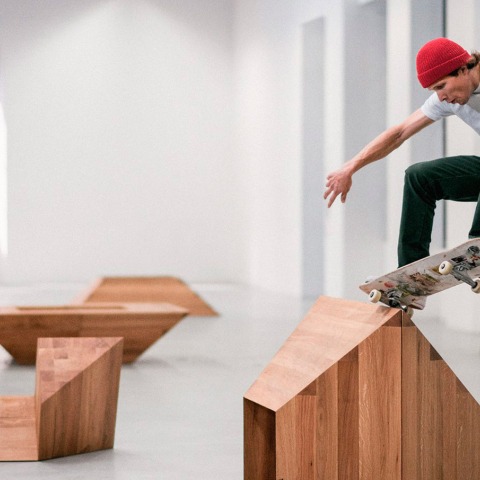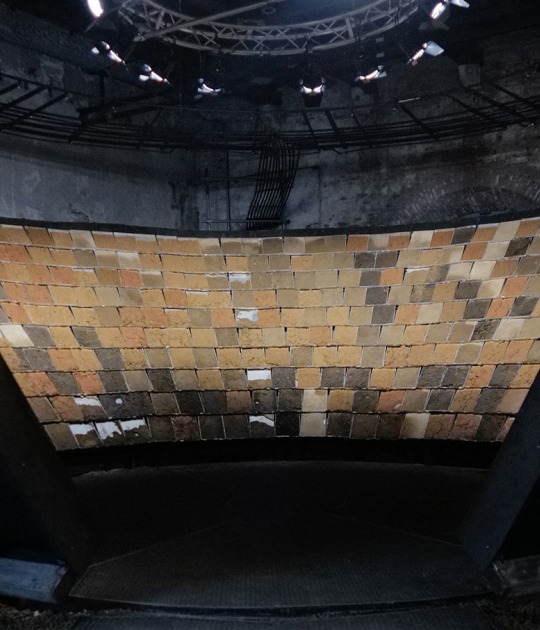In the project for EACC the artist transforms the exhibition hall into a hybrid space where skaters and spectators have to establish their own frameworks of cohabitation.
Raphaël Zarka was born in Montpelier in 1977, and based in Paris, he belongs to a generation of young artists who use found forms as the raw material of their work.
And while the starting point of his work is basically sculptural, he is particularly concerned with art in public spaces and the challenge they pose for artists, rooted in his abiding fascination from a very young age with skateboarding and the whole culture around it. In fact, he has developed this interest in various essays on the history of skateboarding, and on its topography and strategies, and how the experience of skating in different urban sculptures and public areas redefines these places. As such, the artist approaches the practice of skateboarding as a kind of rewriting of spaces conceived for a particular use, to then transfer them to his artistic practice. In this way, he reiterates the same practice that had previously fuelled his interest in abandoned sculptural constructions in order to give them new uses.
By using the concept of “documentary sculptures” with regards his practice, Zarka underscores his desire to voluntarily work with pre-existing forms, which are discovered more than invented. Akin to an archaeologist digging up an object, the artist is concerned not only with what he has found, but also where and how it was found and the history behind it, and he renders his theoretical approach indistinctly across photography, video, sculpture and drawing.
While Zarka’s rethinking of skateboarding is sustained on an ecology of critical and contemporary artistic creation, his interest in reutilisation defines the rendering of his “skateable” sculptures, designed on the basis of scientific objects by the mathematician Arthur Schönflies (1853-1928), little geometrical elements that fit together without leaving empty spaces. Zarka designed these modules by amplifying them to the scale of urban fixtures and thus enabling them to be used by skaters. These corten steel forms, whose angles and planes are perfects for skateboarding, are sculptures in their own right. In consequence, skaters have to adapt to Zarka’s sculptures in the same way as they co-opt the objects they find in the public space, with the scale of the modules being based on the benches used by skaters.
At the same time, the suite of photos Riding Modern Art which illustrates this concept is on show on the upper level of the exhibition hall. These photos, which the artist culled from skateboarding magazines, show various public sculptures used by skaters as ramps, half pipes and so on.
This archive work is basically a work-in-progress begun in 2005 in video format that transformed into a photographic collection from 2007 onwards. Unlike the stance taken by an art historian or critic, here Zarka’s curatorial work is based on a series of images of public sculptures and the use skaters make of them. Renowned sculptors, such as Serra, Deacon, Oteiza and Solano, appear alongside unknown artists or others overlooked by the history of art whose recognition is limited to the local realm. This process also lends emphasis to professional photographers whose images are generally confined to skateboarding publications. Zarka contacts them to propose that they form part of the collection, offering them the same economic conditions as a specialised magazine. Finally, he underscores the strong choreographic quality of the images by registering the figures and forms performed by skaters derived from the geometry of the sculptures, in one way, treating the sculptures almost if they were a music score. Ultimately, in Riding Modern Art Zarka conflates the roles of curator, collector and editor.
Riding Modern Art includes images by : Éric Antoine, Loïc Benoit, Dave Chami, Robert Christ, Jon Coulthard, Ryan Flynn, Gaston Francisco, Matt Georges, Hendrik Herzmann, Nikwen, Tuukka Kaila, Bryce Kanights, Guillaume Langlois, Ludica, Alan Maag, Jonathan Mehring, Ian O'Connor, Patxi Pardinas, Guillaume Périmony, Alberto Polo, Leo Preisinger, Adam Sello, Bertrand Trichet, Seu Trinh, David Turakiewicz, Davy Van Laere, Marcel Veldman, Maxime Verret and Alexis Zavialoff
Raphaël Zarka was born in Montpelier in 1977, and based in Paris, he belongs to a generation of young artists who use found forms as the raw material of their work.
And while the starting point of his work is basically sculptural, he is particularly concerned with art in public spaces and the challenge they pose for artists, rooted in his abiding fascination from a very young age with skateboarding and the whole culture around it. In fact, he has developed this interest in various essays on the history of skateboarding, and on its topography and strategies, and how the experience of skating in different urban sculptures and public areas redefines these places. As such, the artist approaches the practice of skateboarding as a kind of rewriting of spaces conceived for a particular use, to then transfer them to his artistic practice. In this way, he reiterates the same practice that had previously fuelled his interest in abandoned sculptural constructions in order to give them new uses.
By using the concept of “documentary sculptures” with regards his practice, Zarka underscores his desire to voluntarily work with pre-existing forms, which are discovered more than invented. Akin to an archaeologist digging up an object, the artist is concerned not only with what he has found, but also where and how it was found and the history behind it, and he renders his theoretical approach indistinctly across photography, video, sculpture and drawing.
While Zarka’s rethinking of skateboarding is sustained on an ecology of critical and contemporary artistic creation, his interest in reutilisation defines the rendering of his “skateable” sculptures, designed on the basis of scientific objects by the mathematician Arthur Schönflies (1853-1928), little geometrical elements that fit together without leaving empty spaces. Zarka designed these modules by amplifying them to the scale of urban fixtures and thus enabling them to be used by skaters. These corten steel forms, whose angles and planes are perfects for skateboarding, are sculptures in their own right. In consequence, skaters have to adapt to Zarka’s sculptures in the same way as they co-opt the objects they find in the public space, with the scale of the modules being based on the benches used by skaters.
At the same time, the suite of photos Riding Modern Art which illustrates this concept is on show on the upper level of the exhibition hall. These photos, which the artist culled from skateboarding magazines, show various public sculptures used by skaters as ramps, half pipes and so on.
This archive work is basically a work-in-progress begun in 2005 in video format that transformed into a photographic collection from 2007 onwards. Unlike the stance taken by an art historian or critic, here Zarka’s curatorial work is based on a series of images of public sculptures and the use skaters make of them. Renowned sculptors, such as Serra, Deacon, Oteiza and Solano, appear alongside unknown artists or others overlooked by the history of art whose recognition is limited to the local realm. This process also lends emphasis to professional photographers whose images are generally confined to skateboarding publications. Zarka contacts them to propose that they form part of the collection, offering them the same economic conditions as a specialised magazine. Finally, he underscores the strong choreographic quality of the images by registering the figures and forms performed by skaters derived from the geometry of the sculptures, in one way, treating the sculptures almost if they were a music score. Ultimately, in Riding Modern Art Zarka conflates the roles of curator, collector and editor.
Riding Modern Art includes images by : Éric Antoine, Loïc Benoit, Dave Chami, Robert Christ, Jon Coulthard, Ryan Flynn, Gaston Francisco, Matt Georges, Hendrik Herzmann, Nikwen, Tuukka Kaila, Bryce Kanights, Guillaume Langlois, Ludica, Alan Maag, Jonathan Mehring, Ian O'Connor, Patxi Pardinas, Guillaume Périmony, Alberto Polo, Leo Preisinger, Adam Sello, Bertrand Trichet, Seu Trinh, David Turakiewicz, Davy Van Laere, Marcel Veldman, Maxime Verret and Alexis Zavialoff





























